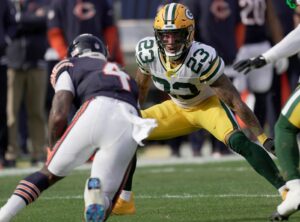The injury rate in professional football is 100 percent. This isn’t breaking news, it’s as much a fact as it is a cliche. Injuries are a natural byproduct of the game. Football is synchronized aggression set in motion with every snap. We marvel at the unfathomable feats of strength and speed as well as ability to repeat them. These things come at a price. For players and fans alike it’s always there, lingering in the back of our minds. The phrase “down on the field” is a most unwelcome one. Many fans of the green and gold believe the Green Bay Packers injuries happen more often than most teams. Is this true, or does our focus on a single team obscure the big picture?
The Truth About Green Bay Packers Injuries
Let’s examine the severity of Packers injuries compared to the rest of the league over the past four seasons. Like the injuries themselves, designations come in varying degrees. Players labeled “questionable” stand a 50/50 chance of playing despite being nicked up, depending on the team.
The Tampa Bay Buccaneers have been quite liberal with the designation, starting more than 90 percent of questionable players over the past two seasons. Conversely, only 32 percent of questionable Pittsburgh Steelers were subsequently activated. Players classified as “doubtful” rarely see any action. By definition, this implies only a 25 percent chance of being active for the game. The actual rate is usually even lower.
A Comprehensive View of Injury Rate
In 2014, the average number of games missed by players on injured reserve was 119 games per team. Green Bay came in above the league average with 159 total games missed. Packers listed as questionable got in the game 66.67 percent of the time, the second highest rate in the NFL.
It’s a subjective thing. Defensive tackle B.J. Raji missed the entire season on injured reserve with a torn bicep. Veteran guard Josh Sitton found himself on the injury report eight times but didn’t miss a single game.
The 2014 season was a relatively healthy one for Green Bay. This good fortune made the disastrous loss to the Seattle Seahawks in the conference championship especially demoralizing. Apart from Aaron Rodgers nursing a calf injury, the team was uncharacteristically healthy, but they failed to capitalize on it.
In 2015, Green Bay only reported 92 player games missed due to injured reserve, which was 19 below the league average. Players were declared “out” only 12 times, less than half of the NFL average. Still, there were notable injuries. This was, of course, the year Jordy Nelson missed the entire season with a torn ACL. Sam Barrington also landed on season-long injured reserve from an ankle injury, and Morgan Burnett (calf) only played in one of the first six games.
Next Man Up
In the NFL excuses are like injuries, everybody has one. The 2016 Packers suffered more games missed on injured reserve than league average, but significantly less in 2017. For the most part, the rate of questionable designations resulting in playing time fell somewhere between 12th highest and 21st. Injury has no rhyme or reason, nor is there a pattern. It is truly an unknown variable.
Granted, when the franchise quarterback breaks his collarbone, the occurrence is magnified due to the impact. Overall, Packers injuries have come at a perfectly unremarkable volume and rate as compared to any other team.
Injuries are part of the game. They’re simply going to happen. Teams can employ different strength and conditioning tactics in an effort to avoid the unavoidable, but the fact is we have modern-day gladiators engaging in high-speed collisions. This is why coaches and general managers covet roster depth. The difference between a Super Bowl run and missing the playoffs is often the skills of the next man up.
Adapt and Overcome
Green Bay had 14 players on injured reserve when they won Super Bowl XLV, many of them key starters. Mark Tauscher, Jermichael Finley, and Ryan Grant were all important pieces of the offense. Defensively, the team was without Morgan Burnett, Mike Neal, and Nick Barnett. In the first half of that Super Bowl, Charles Woodson broke his collarbone. Even after losing their best defensive player, the team persevered.
Sometimes a team will get lucky and survive the arduous season mostly intact and enter the playoffs with a distinct advantage. Most of the time, role players are asked to become difference makers. When a player is replaced by a capable teammate after an injury, it galvanizes the organization when it matters most. Football isn’t the ultimate team sport just because eleven individuals must work as one. It also depends on all 53 players contributing when their number is called.
Frequency Illusion
The best way to describe fan perception of their team’s injuries is the Baader-Meinhof phenomenon. For example, someone who buys a new truck will suddenly notice that particular model on the road and in commercials. This is because of a personal investment in something specific. The same concept applies to a team closely followed by their fan base.
Although it seems as if there is an inordinate amount of Packers injuries, it’s just not the case. It’s all a matter of exposure and perception. When the left guard on your favorite team sprains his ankle, it’s an issue that comes up in the news you pay attention to.
Packer fans likely aren’t aware that the New Orleans Saints logged 384 total games missed by players on injured reserve this season, 170 above league average. The fans down south, however, they know all about it.
Fans will question the strength and conditioning staff as if they aren’t doing their jobs well, but that blame is misplaced. With the advent of nutrition studies and player safety initiatives, hopefully, these numbers will drop. In the end, all we can do as fans is cheer for our team and hope everyone gets up for the next play.






